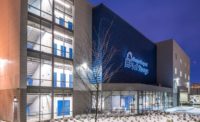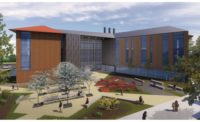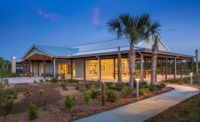Looking at Net Zero
A Passive Path That’s Scientifically Aggressive

Buildings are getting tighter from both the regulatory and the consumer-demand side. As energy codes get steeper, and as consumers expect more sustainable options, architects and builders face new challenges for meeting these standards and expectations without opening the door to unintended consequences. Indeed, the building industry has seen many unintended building failures since we started putting insulation into walls in the 1930s. The good news is that we have learned plenty from them.
Scientific research, best practice guidelines and certification systems can help you sidestep building failures while delivering high-performance buildings. Add inexpensive solar panels to the mix, and buildings that produce as much energy as they use are actually within reach.
Steps on the Path to Net Zero
Gone are the days of 2-by-4 walls with batt insulation between the studs. Thicker walls are the new normal and with them come nonstandard details for constructing buildings. The best path to a zero energy building depends on where the building is located. Your climate zone is the critical first step because it defines what you're up against. Building in San Francisco? The path is wide and gently sloping. Building in Fairbanks? The path is narrow, steep, slippery and built on permafrost. Your climate zone must inform the design strategy because what works in San Francisco, may fail in Fairbanks. Or Spokane.
The path to net zero is not arduous; the steps have been laid over the past decade or so by the Building America program, Energy Star, and public/private partnerships. Those steps are listed below. Of course, I believe that the best path to Net Zero is simply to skip directly to step 4.
Step 1: The 2015 International Energy Conservation Code (IECC) is a good place to begin because, well, it is the law. Even if your jurisdiction hasn't adopted the 2015 code yet, it is wise to get up to speed with what is coming down the pike—blower doors, energy scores and exterior insulation. The 2012 version of the IECC made significant strides in energy performance over the 2009 version. Rather than moving the goalposts further down the field in the 2015 version, the ICC added flexibility in the form of a performance path, making it easier to hit the targets. If you can get the required energy score, you pass.
PHIUS+ certification is already integrated into North America’s policy landscape
PHIUS has worked directly with policymakers across the country on local, state, and national levels to incorporate the PHIUS+ 2015 standard into state and local certifications, standards, and programs. Here are some of the most successful:
Zero Ready Home Certification: All PHIUS+ certified buildings are automatically eligible for The U.S. Department of Energy’s Zero Energy Ready Home certification.
LEED Points: PHIUS-certified projects automatically earn 20 points in Annual energy use. Because PHIUS projects must also earn the DOE ZERH label, they automatically meet many other LEED v4 Homes credits and prerequisites.
Faster permits in Seattle: PHIUS+ 2015 certification qualifies a project for a Priority Green Expedited permit in Seattle, Wash. This green building incentive program offers quick permits in exchange for meeting one of four green building standards.
Training and sustaining in Harlem: PHIUS worked with the NYC Housing Preservation & Development (HPD) organization to formulate the SustaiNYC RFP. PHIUS helped train professionals interested in submitting projects for 100 percent affordable multifamily passive house projects covering almost an entire city block in East Harlem.
Illinois Perks for Passive Peeps: Certifying with PHIUS+ qualifies a project for the Net Zero Energy Building Program from the Illinois Clean Energy Community Foundation. The program awards up to $1 million or 60 percent of the cost of construction to new construction or retrofit projects that achieve net zero energy performance
Step 2: Energy Star 3 and 3.1 is a great next step that will drive home the importance of air tightness, thermal bridges and HVAC design to overall energy use. If you are aiming for net zero, then it is critical to understand how these work together. Even before cheap solar, it is the low-hanging fruit. Energy Star certification is based on climate zones because each place faces different challenges and opportunities.
Energy Star 3.1 was developed after the 2012 IECC passed in order to help building professionals make choices to deliver value and savings in light of the steeper code.
Step 3: DOE's Zero Energy Ready (ZER) Home program is field-tested, performance-tested, and cost-optimized. More than 14,000 energy-efficient homes have been built through the program since 2008. While 14,000 is not mainstream, it is well beyond the boutique market, and it is certainly a large enough sample size to draw performance and cost conclusions.
Passive building pioneers began with thick insulation in the walls and roof. This one-legged stool was a good start, but other legs were needed for a stool that delivered predictable results. Because zero energy buildings are extremely airtight, fresh air must be a big consideration. Leaky buildings from the 80s and 90s have 'inadvertent ventilation’—leaks that provide enough air changes to replace stale air with 'new' air. Problem was, the new air may have come from a radon-loaded crawlspace or a moldy wall cavity. Not great for occupant health.
ZER homes must exceed Energy Star and IECC requirements, while also hitting other health and efficiency targets:
● EPA's Indoor airPLUS certification assures clean, breathable air
● All major appliances must be Energy Star.
● Efficient duct and hot water distribution design mean much less energy is lost getting air and water from point A to point B.
The ZER Home program is essentially a system of existing certifications combined to deliver something better.
Step 4: Passive Building certification is the pinnacle of high-performance, the most common certification in North America is PHIUS+, administered by the Passive House Institute US.
PHIUS+ is a self-contained package that delivers predictable results. Where ZER homes combine several discrete performance certifications, PHIUS+ puts it all together into a cost- and climate-optimized package, with quality assurance at its center. PHIUS+ projects are modeled using the WUFI Passive hydrothermal modeling software, and the models are remarkably accurate, as recently published

Real results show an accurate model. Based on two recent multifamily projects in climate zone 4 and 4 (marine). The two passive building models predicted surprisingly different results for total site energy savings over the baseline ASHRAE energy efficiency model. The PHIUS+2015 model, using WUFI Passive, predicted a ±30 percent improvement over the ASHRAE 90.1-2010 model. The Passivhaus model predicted an improvement over ASHRAE 90.1-2010 of 50-60 percent. Overpredicting performance can leave a bad taste in customers' mouths.
All PHIUS+ certified buildings are automatically eligible for ZER certification too because PHIUS+ was developed in part with the U.S. Department of Energy to be comprehensive and scientifically sound.
Based on Science and Experience
The building blocks of Passive Building come from the same building blocks as the baby steps on the path because you can't argue with physics. And the result is substantially more comfortable, durable, healthful and predictable than partial measures cobbled together.
Fast forwarding past the deep physics of Passive Building, it boils down to five building science principles:
1. Continuous insulation interrupts thermal 'bridges' between inside and out

Thick and continuous insulation keeps the air inside cool in summer. and warm in winter. Capaces Leadership Institute in Woodburn, Ore. uses a Larsen Truss system outside the walls to add dense-pack cellulose insulation. Rigid insulation wraps down and under the slab, while thick roof framing makes plenty of space for dense-pack insulation. Image courtesy of GreenHammer Design | Build | Energy
By completely wrapping a building with insulation, heat can no longer sneak out through framing which has a lower in R-value than the insulation between the studs. Masonry chimneys that connect inside and out are another example of an often-overlooked thermal bridge. In multifamily housing, cantilevered concrete balconies inadvertently transform high rise buildings into giant radiators.
Continuous, thick insulation on the outside of a building keeps heat flow to a minimum.
2. Airtight construction stops heat and moisture

Windows can be very leaky if you let them. Air sealing, water sealing and thermal boundaries are sometimes specified on sets of plans using different colors. Photo courtesy of Alison Kwok, © 2017 Passive House Details: Solutions for High-Performance Design.
While thick, continuous insulation can stop a significant amount of heat loss through conduction, plugging air leaks can show heat flow, too. Because temperature gradients drive conduction currents, the air that moves through buildings usually carries a lot of heat with it.
And here's the rub: warm air can hold more moisture than cold air. So when warm air leaks through electrical outlets into exterior wall cavities, it dumps moisture into the wall cavity when the warm moist air hits the cold wall sheathing. The same is true in summer, only in reverse. Air conditioned buildings are cooler and drier, so hot humid outside air that is sucked into walls will dump moisture on the paper backing of the drywall. Paper backing on drywall makes terrific mold food.
There are a lot of holes, gaps, and cracks in typical building that can add up to cause a lot of hidden rot problems while also wasting energy.
3. Optimized windows let heat in when (and only when) you want them to

Swinging windows are tighter. Casements and awnings are more airtight than sliding windows, like double-hungs. Triple glazing and insulated frames are also key energy details to specify. Photo courtesy of Alison Kwok, © 2017 Passive House Details: Solutions for High-Performance Design.
Windows have a tough job description: plug a hole in the wall, stop air, water and heat, open and close, look good and be transparent. Of all these demands, stopping heat flow is the most difficult to achieve because glass has an extremely low R-value. Multiple panes of glass with inert gas between the panes can slow conduction much more effectively than a single page of glass. Double glazing with argon gas is typical of Energy Star windows. Passive buildings usually have triple glazing. U-factor (the inverse of R-value) measures heat flow through windows. The appropriate window u-factor depends on your climate zone—cold climates need lower u-factors than hot climates because the temperature extremes are greater.
But heat flow does not stop at conduction. A lot of heat can pass through windows by radiant transfer. Free heat in the winter is a welcome addition that lowers the work that a heating system must do. Free heat in the summer is the opposite: it causes the AC system to work harder. Low e coatings applied to the surface of the glass can block radiant heat transfer. They can also be fine-tuned to the desired amount of heat gain. This is measured with a solar heat gain coefficient (SHGC). High SHGC windows should be used on sides of the house where winter sun is wanted: generally on the east and south sides. Low SHGC windows should be used where summer sun will do the most harm: generally west-facing windows.
4. Balanced ventilation ensures fresh air—and controls moisture

Balanced ventilation that doesn't lose its temper. Two heat recovery ventilator units (HRVs) exchange air between inside and out through a common supply duct. incoming air at the Capaces Leadership Institute is tempered by outgoing air to capture energy and reduce waste. Short sections of flex duct reduce noise due to vibration. Image courtesy of GreenHammer Design | Build | Energy.
All the aforementioned air tightening means that dirty, moist air isn't leaking into the living space, so air changes must be controlled with some sort of high-tech fan. One option is an energy recovery ventilator (ERV), which pulls new air in and pushes old air out while transferring heat and moisture in the process.
The living space is supplied with a constant flow of fresh air without pulling in hot, cold, or wet air that the heating and cooling system must condition.
5. Minimal mechanical is all a super tight building needs
Because the building is super tight, super insulated and has super windows, super-size heating and cooling systems are unnecessary. This is where the upfront investment begins to pay off because mechanical systems can get expensive. Some of the money that was spent up front on insulation and windows can be recouped with much smaller mechanical systems. In single family homes, this can be attractive savings.
Big Chance to Dive Deep: 2017 North American Passive House Conference in Seattle
The 12th Annual North American Passive House Conference in Seattle (September 27 - October 10) is focused on cost-optimized paths to zero energy and will feature multiple case studies from multiple climate zones.
Newbies can delve into pre-conference presentations at the Seattle Public Library while veteran energy pros will likely dive deep into the building science sessions. Everyone can enjoy tours of successful passive projects around the Seattle-area.
The networking opportunities are tremendous. Connect with building professionals from all over the world at all levels of expertise who together are helping to accelerate change in high-performance building design and construction.
In multifamily buildings and commercial buildings, the savings compound quickly. In fact, a 58-bed long-term health care facility in Spokane, Wash. cost less to build ($132/square foot) than typical built-to-code construction. Passive building was essential in this case because of the residents, older people, who are very sensitive to heating fluctuations and air quality.
The developers did not go into the project looking for a high-performance solution, they went in with extremely tight cost-tolerances, looking for value. PHIUS+ delivered up-front and down-the-road value with superior comfort and performance.
Cost-Optimized Comfort and Performance
When these five principles are applied to buildings—single-family homes, apartment buildings, offices and skyscrapers—you get predictable performance, but also unmatched comfort for the occupants, superb air quality and resiliency in the face of power outages due to winter storms or summer blackouts.
Best of all, because passive buildings consume so little energy, zero energy is right within reach. Just add a small renewable energy system, like PV, and you are there: at the end of the path to zero.
Looking for a reprint of this article?
From high-res PDFs to custom plaques, order your copy today!





